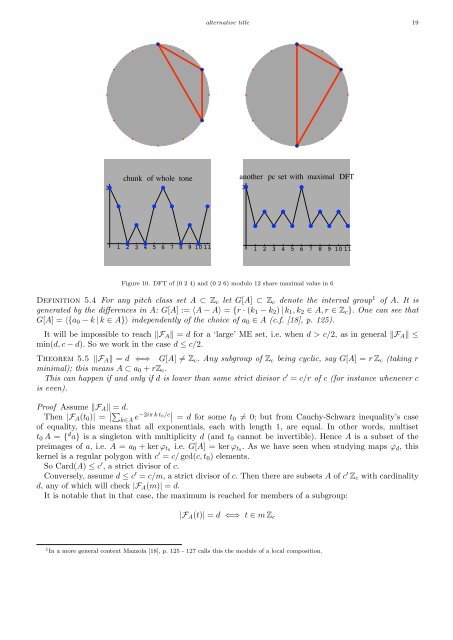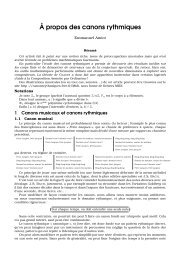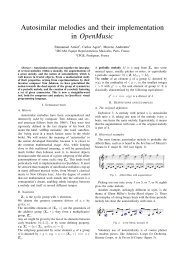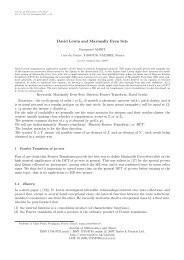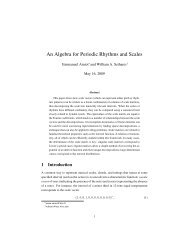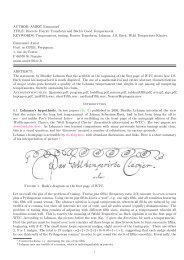Emmanuel Amiot Modèles algébriques et algorithmes pour la ...
Emmanuel Amiot Modèles algébriques et algorithmes pour la ...
Emmanuel Amiot Modèles algébriques et algorithmes pour la ...
You also want an ePaper? Increase the reach of your titles
YUMPU automatically turns print PDFs into web optimized ePapers that Google loves.
3<br />
chunk of whole tone<br />
1 2 3 4 5 6 7 8 9 10 11<br />
alternative title 19<br />
another pc s<strong>et</strong> with maximal DFT<br />
3<br />
1 2 3 4 5 6 7 8 9 10 11<br />
Figure 10. DFT of (0 2 4) and (0 2 6) modulo 12 share maximal value in 6<br />
Definition 5.4 For any pitch c<strong>la</strong>ss s<strong>et</strong> A ⊂ Zc l<strong>et</strong> G[A] ⊂ Zc denote the interval group 1 of A. It is<br />
generated by the differences in A: G[A] := 〈A − A〉 = {r · (k1 − k2) | k1, k2 ∈ A, r ∈ Zc}. One can see that<br />
G[A] = 〈{a0 − k | k ∈ A}〉 independently of the choice of a0 ∈ A (c.f. [18], p. 125).<br />
It will be impossible to reach FA = d for a ‘<strong>la</strong>rge’ ME s<strong>et</strong>, i.e. when d > c/2, as in general FA ≤<br />
min(d, c − d). So we work in the case d ≤ c/2.<br />
Theorem 5.5 FA = d ⇐⇒ G[A] = Zc. Any subgroup of Zc being cyclic, say G[A] = r Zc (taking r<br />
minimal); this means A ⊂ a0 + rZc.<br />
This can happen if and only if d is lower than some strict divisor c ′ = c/r of c (for instance whenever c<br />
is even).<br />
Proof Assume FA = d.<br />
Then |FA(t0)| = <br />
k∈A e−2iπ k t0/c = d for some t0 = 0; but from Cauchy-Schwarz inequality’s case<br />
of equality, this means that all exponentials, each with length 1, are equal. In other words, multis<strong>et</strong><br />
t0 A = { d a} is a singl<strong>et</strong>on with multiplicity d (and t0 cannot be invertible). Hence A is a subs<strong>et</strong> of the<br />
preimages of a, i.e. A = a0 + ker ϕt0 i.e. G[A] = ker ϕt0. As we have seen when studying maps ϕd, this<br />
kernel is a regu<strong>la</strong>r polygon with c ′ = c/ gcd(c, t0) elements.<br />
So Card(A) ≤ c ′ , a strict divisor of c.<br />
Conversely, assume d ≤ c ′ = c/m, a strict divisor of c. Then there are subs<strong>et</strong>s A of c ′ Zc with cardinality<br />
d, any of which will check |FA(m)| = d.<br />
It is notable that in that case, the maximum is reached for members of a subgroup:<br />
|FA(t)| = d ⇐⇒ t ∈ m Zc<br />
1 In a more general context Mazzo<strong>la</strong> [18], p. 125 - 127 calls this the module of a local composition.


